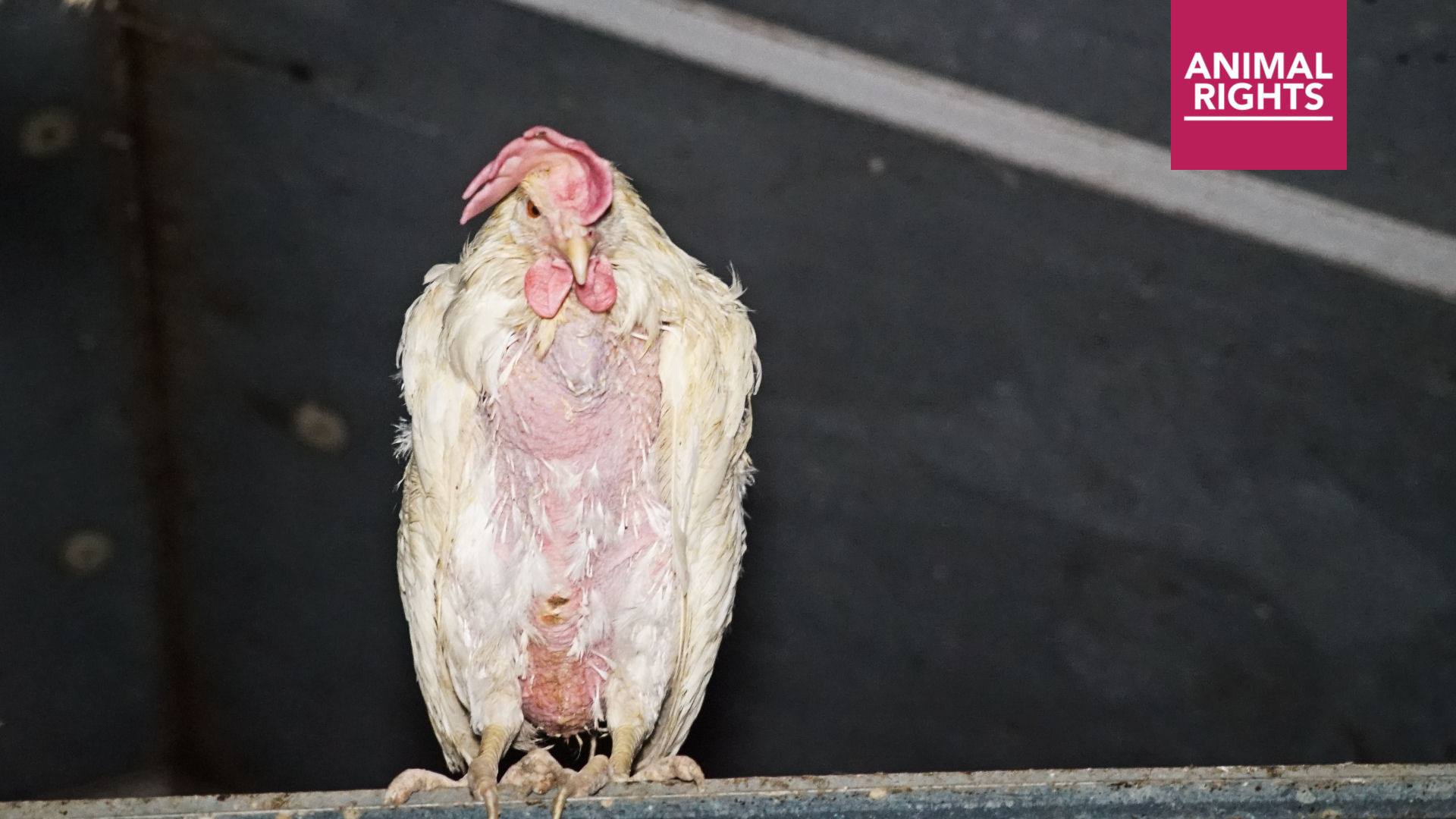Partido para os Animais reforça debate sobre o sofrimento de animais na indústria pecuária
On the Party for the Animals’ (PftA) insistence a big debate will be held in the Dutch Lower House on the suffering and dying of animals in the livestock industry. PftA’s parliamentary leader Esther Ouwehand: “A radical change of course is needed, involving a transition to an agriculture in which we do justice to animals.”

A chicken in a Dutch “horror stable” (picture by Animal Rights)
The debate will be held on the 24th of January next. The Dutch Party for the Animals wants to use this debate to force the Minister of Agriculture and colleague politicians to take a good look at themselves: when is the line crossed in terms of animals suffering in the livestock industry?
Several reports show structural malpractices in Dutch livestock farming. Last week it appeared that sows are so severely overbred to farrow as many piglets as possible that millions of piglets are suffering badly in the maternity barn. Ten years ago, the sector promised to push back piglet mortality, but those figures only grew after that. Additionally, the air in pig barns is so poisonous that more than half of the pigs in the Netherlands catch pneumonia.
The animal rights organisation Animal Rights recently published a series of videos of Dutch barns. Those prove that the reality for animals is completely different than what the livestock industry, supermarkets and government make it look like: bald and weakened chickens, which can hardly walk, among dead species in barns. Piglets and their mothers live above their own excrements on a concrete slatted floor in unfurnished, often dirty cages. The Association of Dutch Veterinarians ‘Caring Vets’ confirms that these type of practices are no exception but normal in everyday life in the livestock industry.
Esther Ouwehand of the Party for the Animals wants to have some crucial questions answered in the coming debate: “The key question is: How can those practices be legal? The follow-up question is: If this is legal, why are people not allowed to see it? Certainly if you make the customer responsible, you have the duty to inform them truthfully and completely about where their animal products come from. For that reason, the Minister must 1) acknowledge that there is a gigantic gap between the picture presented and reality in livestock farming and 2) to distance herself from the tactics of the sector to criminalise messengers such as Animal Rights. The right to information is a core value in a democracy.”
Com a insistência do Partido para os Animais (PftA – sigla em inglês), um grande debate será realizado na Câmara dos deputados holandesa sobre o sofrimento e a morte de animais na indústria pecuária. A líder parlamentar do Partido para os Animais, Esther Ouwehand salienta: “É necessária uma mudança radical de curso, iniciar uma transição para uma agricultura na qual façamos justiça aos animais”.

Uma galinha em “um galinheiro do horror na Holanda” (foto de Animal Rights)
O debate será realizado no próximo dia 24 de janeiro. O partido para os animais holandês quer usar este debate para forçar o ministro da agricultura e outros políticos a fazerem uma autoanálise: quando a linha do sofrimento e crueldade animal é cruzada na indústria pecuária?
Vários relatórios mostram irregularidades estruturais na pecuária holandesa. Na semana passada, verificou-se que porcas são sistematicamente mantidas grávidas para que possam procriar o máximo possível e consequentemente, leitões estão a sofrer nas ‘maternidades-estábulo’. Há dez anos, o setor prometeu reduzir a mortalidade de leitões, mas esses números só cresceram depois disso. Além disso, o ar nos celeiros de suínos é tão venenoso que mais da metade dos porcos da Holanda contraem pneumonia.
A organização de direitos dos animais Animal Rights publicou recentemente uma série de fotos de celeiros holandeses. Eles provam que a realidade dos animais é completamente diferente do que a indústria pecuária, os supermercados e o governo fazem parecer: galinhas carecas e enfraquecidas, que mal conseguem andar, entre espécies mortas em celeiros. Leitões e suas mães vivem acima de seus próprios excrementos em um piso de concreto em gaiolas carentes de tudo, muitas vezes sujas. A Associação de Veterinários Holandeses “Caring Vets” confirma que esse tipo de prática não é exceção, mas é normal na vida cotidiana da indústria pecuária.
Esther Ouwehand, do Partido para os Animais, quer que algumas perguntas cruciais sejam respondidas no próximo debate: “A questão chave é: como essas práticas podem ser legais? A pergunta seguinte é: Se isso é legal, por que as pessoas não podem vê-lo? Certamente, se você responsabilizar o cliente, você tem o dever de informá-lo de forma verdadeira e completa sobre a procedência de seus produtos de origem animal. Por essa razão, o ministro deve 1) reconhecer que há uma lacuna gigantesca entre o quadro apresentado e a realidade na pecuária e 2) se distanciar das táticas do setor criminalizando os mensageiros como por exemplo, a Animal Rights. O direito à informação é um valor fundamental em uma democracia”.